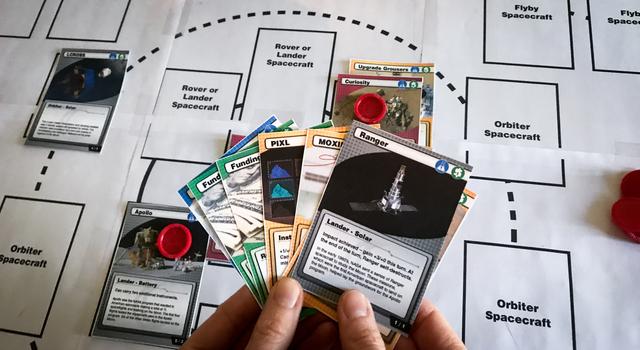Classroom Activity
What Tools Would You Take to Mars?
- See tips for remote instruction in the Management section.
Overview
In Part Two of this three-part lesson, students add to a KWL (Know, Want, Learn) chart created in Part One and decide what they want to learn from a robotic mission to Mars. They will decide how their robot will move on Mars and which tools to put on their robot to accomplish their goals.
Materials
Management
- A KWL (Know, Want, Learn) chart is an organizational tool used to help students connect learning to what they already know, identify what they want to learn about a subject, and reflect on their learning.
- Encourage students who do not yet have writing skills to explain why they chose the method of movement and the tools they chose.
- This is Part Two of a three-part lesson designed to help students develop questions about Mars. Part One, "What Do You Know About Mars?", should be completed first.
Tips for Remote Instruction
- This lesson can be conducted in an in-person classroom setting or via online technology. If using online technology, consider using a shared document or slide that multiple students can edit together to build a KWL chart for the class.
Background
NASA sends missions to Mars so we can learn more about our home planet, Earth. Mars and Earth may have been quite similar when they formed, but now Mars is cold and dry and has very little atmosphere. Scientific evidence tells us that Mars once had a global ocean. What happened to it? Did that global ocean and its many Martian rivers once support life? These are just some of the questions scientists are hoping to answer.
NASA explores Mars using three types of spacecraft:
- Orbiters – spacecraft that circle Mars, take images, and make scientific observations from space, but do not land
- Landers – spacecraft that land on the surface of Mars, take images, and make scientific observations from one location
- Rovers – spacecraft that land on the surface and then drive around to numerous locations to take images and make scientific observations
For this lesson, we will focus on a Mars rover as it is easier for young students to relate to a rover than an orbiter or lander. However, this lesson is appropriate for use with an orbiter or lander mission.
Rovers can use many different methods of locomotion, or moving. They can use wheels, legs, tank treads, or they can roll, hop, or slither. Encourage students to use their imagination in thinking about how a rover they design might move.
Mars rovers carry numerous scientific tools, or instruments, that help scientists gain answers to their questions. Some of these tools, such as cameras or even drills, will be familiar to most students. Other tools, such as microscopes, thermometers, and lasers will likely be unfamiliar and need more explanation.
Procedures
- Review the Mars KWL chart your class created in the previous lesson.
- Explain to students that today they are going to decide how their rover will move and what tools they would put on a rover to accomplish their scientific mission – or find out what they want to know about Mars. Remind students that a rover is a robot that goes by itself to Mars. No humans go with it.
- Explain to students that their scientific mission is to gain answers to their questions from the KWL chart.
- Explain to students that their rover needs to be able to move. Brainstorm how things move (e.g., insects use legs, fish use fins, birds use wings, cars use wheels).
- Ask students to decide how their robot will move. Have them circle the option they choose on the student worksheet or draw their own ideas.
- Explain to students that they can take any tool they want to Mars to help them answer questions as long as it’s small enough to fit on a rover. Ask students to suggest tools they might put on their rover. If students suggest a tool that is larger than a car, ask them to think about what part of that tool is most important and whether that part would fit on a rover. For example, if students suggest taking a bulldozer to Mars, show them a picture of a bulldozer and talk about which part of the bulldozer is doing the work they want to do on Mars. They will likely identify the front bucket or scoop of the bulldozer. Explain that they can take a smaller scoop to Mars and that would fit on a rover.
- Have students circle the tools they choose on the student worksheet or have them draw their own ideas.
Discussion
Ask students to provide reasoning for which tools they chose to bring to Mars.
Assessment
Students should select tools that can help answer their questions about Mars (e.g., a student chooses a thermometer to answer the question, “How cold is it on Mars?”).
Extensions
Part three of this three-part lesson is coming soon ...









